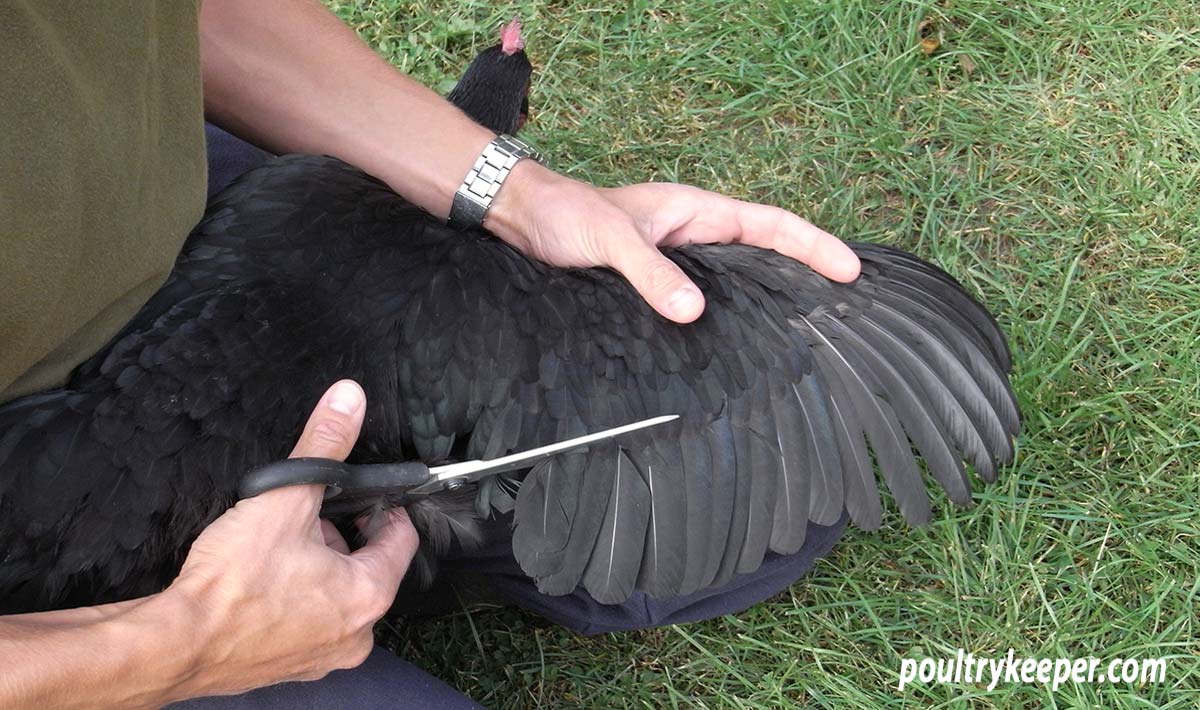
Whilst many heavy breeds of chickens can’t really fly high, and a modest fence height will keep them in, the Mediterranean light breeds are very capable of flying over a substantial six-foot fence. This article will show you how to clip a chicken’s wing so she can’t fly.
Sometimes we need to clip a chicken’s wing to stop her from flying. It may be essential to keep her safely confined behind a fence, away from predators, or to stop her from getting to your prize-winning vegetable garden!
Before you learn how to clip chicken wings, you should first consider whether it is necessary. Heavy breeds such as Orpingtons can’t fly very well but lighter, Mediterranean breeds such as Leghorns can fly reasonably well though, and some bantams can fly almost vertically.
If in doubt, (and assuming it is safe), why not let your birds settle into their enclosure and see whether they can get out? Remember with a clipped wing; it will also make it harder for them to fly away from any predators in an emergency.
Quick Questions
Feathers are about 85% keratin, a dead fibrous substance formed by living cells.
Once feathers are fully developed, they do not receive nourishment and are not living structures, so similar to cutting your hair or nails, clipping a chicken’s wing does not hurt.
Feathers are about 85% keratin, a dead fibrous substance formed by living cells.
Once feathers are fully developed, they do not receive nourishment and are not living structures, so similar to cutting your hair or nails, clipping a chicken’s wing does not hurt.
Since it does not hurt a chicken to clip her wing, and she can still exhibit all of her natural behaviours and is still likely to be able to jump up/fly to a short height (for example to roost), so I don’t believe it is cruel to clip a wing.
Yes.
An adult chicken will moult every year in the late summer/early autumn. She will replace all of her feathers with new ones. Once they are fully grown, you will need to clip her wing again if it’s still necessary (she might have got out of the habit of jumping over the fence by then, so she won’t try to escape any more).
While feathers are still growing, there is blood inside the shaft of the feather.
Growing feathers should not be cut.
Fortunately, you can look at the base of the feather and see which feathers are still growing.
- Fully formed feathers are empty/clear or white.
- Growing feathers are dark/black.
Chickens grow until they are about 18 to 24 weeks old. Heavy breeds take the longest time to mature fully.
Depending on how hard you have clipped the wing (see the wing clipping diagram) and how good she is at flying!
Some chickens continue to escape and need both primary and secondary feathers trimming, while others don’t need much to unbalance them, which puts them off trying in the first place.
Generally speaking, she shouldn’t be able to fly more than waist height with a clipped wing without veering off course and coming back down to the ground.
Wing clipping diagram
Note that many diagrams shown on websites are mislabeling the secondary feathers. The Primaries are the ten large flight feathers on the wing’s outer part when you extend the wing. The Secondaries are the next set of feathers nearest the body. The feathers that overlap these feathers are the Flight Coverts (not the secondaries as some sites suggest).
I like to divide wing clipping into three increasing severities, so I am only cutting the minimum number of feathers necessary to prevent the bird from flying.
Although it causes no pain to take more off, it looks neater when she tucks away her wing if some feathers are left.
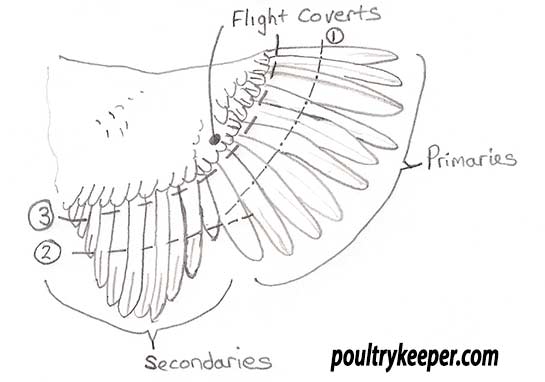
How to clip a chicken's wing in 3-easy stages
Here is how to clip a chicken’s wing in three stages, cutting only enough feathers to stop the chicken from flying.
- Only clip ONE wing to unbalance the bird. If you clip TWO wings, they can often still fly by flapping harder!
- Hold the chicken firmly on your lap so she can’t flap the wing (you may find this more comfortable with two people).
Preliminary check: Have feathers stopped growing?
Firstly, do not cut growing feathers that are full of blood. The shaft should be are white/clear. When feathers grow, they are full of blood and appear very dark / almost black. Do not trim these until they have finished growing.
You can still trim feathers that have stopped growing, leaving the few blood-filled feathers for another day.
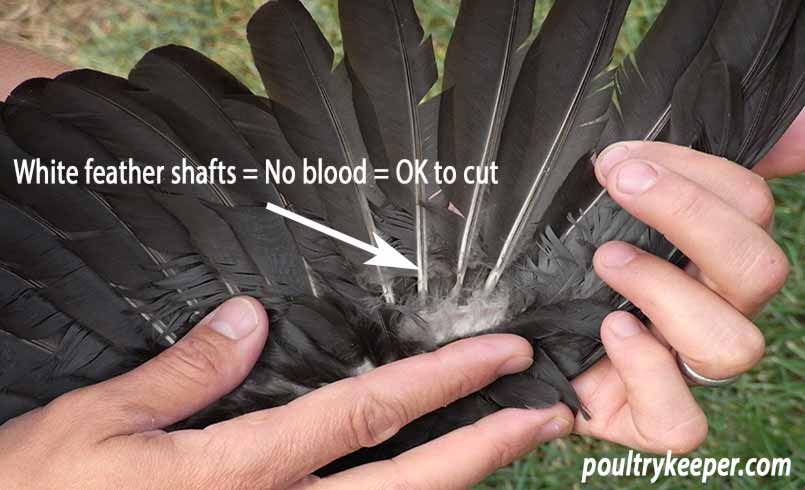
Follow these three-stages of trimming. The idea is to cut off enough to stop the chicken from flying but not leave a harsh looking outline when the wing is closed.
We will follow the cuts in number-order on the wing clipping diagram above, starting with primary flight feathers:
1. Trimming primary flight feathers
It usually is only necessary to shorten Primary Flight Feathers by 50% as shown by cutting along line 1 in the wing clipping diagram above, using a pair of sharp kitchen scissors. Lighter breeds or flighty hybrids may need a little more cutting off the primaries.
For determined flyers, they will still manage to fly unless you clip the wing a little harder.
2. Trimming the secondary flight feathers
If the bird can still fly, you may need 50% of the secondaries trimmed too. I show this as line 2 on the diagram. Again, the same rules apply, take it in gentle stages and check for growing feathers full of blood.
3. Clipping the entire wing
Particularly flighty birds may need both primary and secondaries trimmed back hard as shown in line 3. It is quite extreme, so it is best to go in gentle stages if you can.
This clipping takes primary and secondary feathers right back to the flight coverts.
This chicken was regularly jumping over the fence, and I was concerned about a fox snooping around getting her for dinner.
Foxes can scare chickens and could cause her to fly. The safest way to ensure her safety was to keep her on the ground inside the run.
It was an excellent opportunity to take some photos to show you how to clip a chicken’s wing.
To do a neat job when trimming this hard, you can lift the flight coverts before cutting each primary feather so that the cut is hidden by the coverts afterwards.
You can also use sharp wire cutters/nail clippers to trim each feather. Bend each feather by 90-degrees first before cutting to make it easier. It takes longer but leaves a tidier job.
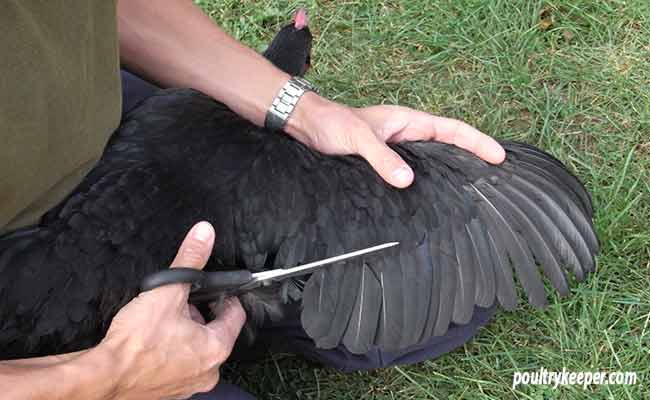
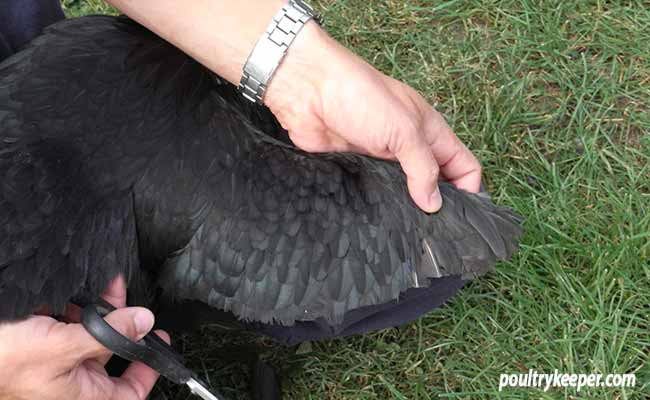
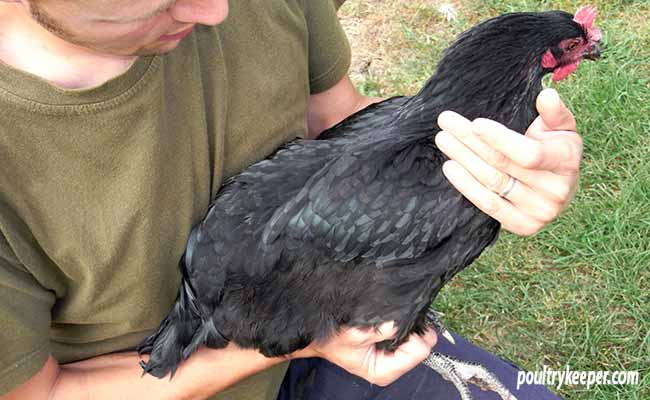
Clipping the entire wing does give the bird quite a harsh outline around the wing area as you can see, so I only resort to cutting both primary and secondary feathers when necessary.
If you clip only secondary feathers, you’ll find the primaries cover them when the wing is closed, and the bird won’t look any different.
Clipping a chickens wing does not hurt her once the feather is fully grown. After a moult, feathers will regrow anyway, so don’t worry too much if you have gone a little too far.
The annual moult
Don't forget feathers will regrow!
Adult chickens moult, losing and replacing all of their feathers annually. It takes place in the late summer, early autumn.
If you have clipped a chicken’s wing to stop her from flying, you will need to repeat this once she has moulted and her feathers have regrown.
Be very careful not to clip the feathers too early since blood is inside the quill when growing. If you cut it too soon, it will bleed profusely and be very difficult to stop.
Feathers whose quills are full of blood will appear dark, almost black instead of clear/white.
You can find more information in my guide on Moulting Chickens.
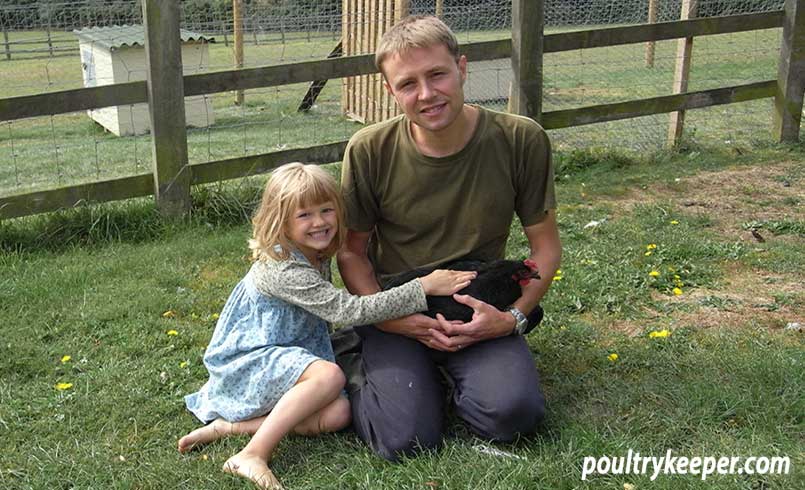
You will be pleased to know that our escaping chicken couldn’t get out with her wing clipped and the fox never got his chicken dinner.
Now you know how to clip a chicken’s wing, please let me know if you found it easy to follow. Is there anything else I should add to this article? Feel free to leave me a comment below.




